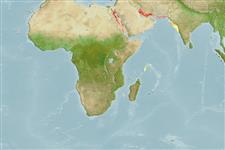>
Anguilliformes (Eels and morays) >
Congridae (Conger and garden eels) > Heterocongrinae
Etymology: Gorgasia: From Greek mithology, Gorgas, -ados = the Gorgone´s head (Ref. 45335).
Environment: milieu / climate zone / depth range / distribution range
Ekologi
laut dasar (demersal). Tropical
Western Indian Ocean: Gulf of Aqaba, Red Sea.
Size / Weight / umur
Maturity: Lm ? range ? - ? cm
Max length : 83.8 cm TL jantan/; (Ref. 33408)
Life cycle and mating behavior
Kematangan | Reproduksi, perkembang biakan | Pemijahan | telur-telur | Fecundity | Larva
Spawning begins early in the morning. From variable colonies in a reef, each eel occupies a burrow it has dug, reaching into the water column to pick out the plankton for food. Prior to spawning, the male and female move their burrows close together; whether the male or the female moves is not known. The male then defends the female from other males, and prolonged and vigorous inter-male combat is common.
On the day of spawning, the male extends out of his burrow toward the female. Both spread their dorsdal fins broadly and the male rubs his head over the female's body. If not ready, the female withdraws into her burrow; if ready, she extends toward the male and wraps her body once or twice around his, bringing her urogenital opening close to his. The pair remains in this position until spawning occurs, which may take up to nine hours or more.
Castle, P.H.J. and J.E. Randall, 1999. Revision of Indo-Pacific garden eels (Congridae: Heterocongrinae), with descriptions of five new species. Indo-Pac. Fish. (30):52 p. (Ref. 33408)
Status IUCN Red List (Ref. 130435)
ancaman kepada manusia
Harmless
penggunaan manusia
informasi lanjut
Umur / Saiz
Pertumbuhan
panjang-berat
panjang-panjang
ukuran frekuensi
Morfometrik
Morfologi
Larva
Dinamika larva
pemulihan
Kelimpahan
BRUVS
AcuanBudidaya airprofil budidaya airStrainGenetikaElectrophoresesDiturunkanPenyakit-penyakitPengolahanNutrientsMass conversion
mitraGambarStamps, Coins Misc.Suara-suaraCiguateraKecepatanTipe renangArea insangOtolithsOtakPenglihatan / visi
Alat, peralatan
laporan khas
muat turun XML
Sumber internet
Estimates based on models
Preferred temperature (Ref.
123201): 25 - 27.4, mean 26.7 °C (based on 34 cells).
Phylogenetic diversity index (Ref.
82804): PD
50 = 0.5001 [Uniqueness, from 0.5 = low to 2.0 = high].
Bayesian length-weight: a=0.00102 (0.00046 - 0.00225), b=3.06 (2.88 - 3.24), in cm total length, based on all LWR estimates for this body shape (Ref.
93245).
Trophic level (Ref.
69278): 3.4 ±0.4 se; based on size and trophs of closest relatives
Daya lenting (Ref.
120179): sedang, Waktu penggandaan populasi minimum 1.4 - 4.4 tahun (Preliminary K or Fecundity.).
Fishing Vulnerability (Ref.
59153): Moderate to high vulnerability (54 of 100).
